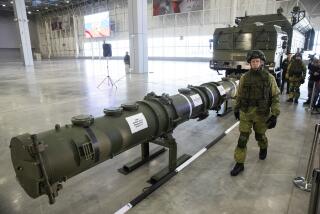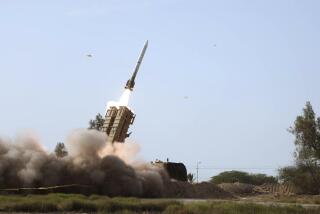Missiles: Get It Right
The 1991 collapse of the Soviet Union did not end the threat of a ballistic missile attack on the United States. If anything, the danger might have increased. Throughout the Cold War a rough U.S.-Soviet strategic equilibrium--what came to be known as the balance of terror--virtually assured that neither side would invite its own destruction by attacking the other. Whether the same rational restraint will guide the handful of countries that are now working hard to develop their own long-range missiles is a question that needs answers.
The Clinton administration agrees with Republicans that the potential of a missile attack, as Defense Secretary William S. Cohen put it, “is a threat that is growing.” President Clinton’s new budget proposes adding $6.6 billion over the next five years to the $4 billion already budgeted to develop a national missile defense system (NMD) to defend against a limited attack. But Clinton wants to put off until June 2000 a decision on whether to deploy the system, and he wants to win Russian agreement to amend the 1972 Antiballistic Missile Treaty to permit such a system.
After initially balking at those conditions, congressional Republicans this week reached a compromise with the White House. The result: On Wednesday the Senate, on a 97-3 vote, endorsed deployment “as soon as technologically possible” of a system to protect all 50 states against attack from any country that might be able to launch just a few missiles, rather than the overwhelming number the Soviet Union was capable of firing. Approval by the House of a similar measure could come today.
Support for the national missile defense system increased dramatically last July with a report by a special commission headed by Donald Rumsfeld, Defense secretary in Gerald Ford’s administration. The commission found that the missile threat to the United States was more serious than intelligence estimates had held.
In time both Cohen and CIA Director George J. Tenet came to echo that assessment. The commission reported that North Korea, Iran and Iraq could, within five years of deciding to do so, field missiles capable of reaching the continental United States. Little more than a month after the commission’s report, North Korea surprised American officials and shocked Japan by testing a three-stage missile that passed over the Japanese island of Honshu before falling into the Pacific nearly 3,000 miles from its launch pad. Successful Iranian missile tests and new concerns that China may be pursuing an improved intercontinental missile program boosted backing for the antimissile system.
The national missile defense system is envisioned as land-based (though some argue it would be cheaper and more effective to put it aboard ships), in contrast to the never perfected space-based Strategic Defense Initiative, on which $36 billion was spent during Ronald Reagan’s presidency. But NMD is a concept still far from realization. Neither an interceptor rocket nor a proven “kill vehicle” to destroy an incoming missile yet exists. An effective defensive system would also have to be able to distinguish between incoming warheads and dummies meant to decoy interceptors.
Destroying a warhead in space is enormously difficult. Even if the technical problems can be resolved, deployment of NMD is at least five years away. Meanwhile, the administration will have to persuade a suspicious Russian government that a limited antimissile system would not alter the strategic balance that the ABM Treaty is meant to support.
However dismissive congressional Republicans might be of Moscow’s concerns, Washington must deal with the fact that Russia retains thousands of nuclear weapons. The second Strategic Arms Reduction Treaty--which the Russian parliament, finally, might soon take up--is a cornerstone of U.S. efforts to shrink costly, redundant and dangerous nuclear arsenals. That policy goal should not be put at risk.
The missile threat from rogue states has to be taken seriously. North Korea, Iran and Iraq don’t need long-range missiles to intimidate their neighbors; it’s the United States they have in mind. Is a defense against this threat feasible? A rushed and wastefully expensive program that proves to be ineffective would do nothing to make Americans more secure. Doing it right is more important than doing it quickly.
More to Read
Sign up for Essential California
The most important California stories and recommendations in your inbox every morning.
You may occasionally receive promotional content from the Los Angeles Times.










